
All vehicles include current protection to limit the damage should something short out or draw more power than the wiring can handle. The objective is to disconnect a circuit that exceeds the design limits. Tesla’s older vehicles use multiple fuses, similar to ICE vehicles. With the release of the Model 3, Tesla switched to electronic fuses that eliminate the need for physical fuses and Tesla uses this advanced technique today in all its new vehicles. (Feb-2023)
If you are looking for locations to obtain power for an accessory, check out our companion article: Accessory Power Guide
Model 3/Y and Palladium S/X
All Model 3 and Model Y vehicles use advanced current protection, as do the Model S and Model X manufactured after February 2021 (LR/Plaid).
Electronic Fuses
Electronic low-voltage fuses are a major advancement in vehicle protection. This system uses current sensors to detect an overcurrent condition, and under such conditions, electronically removes power from the circuit. As far as we know, Tesla is the only vehicle manufacturer using this system. Benefits include:
- Automatic reconnection when the fault is fixed
- Elimination of relays
- Improved reliability
- Faster disconnection on overload
- Less wiring
- Logging of intermittent issues
- Lower weight
- No fuse or relay replacements ever needed
- Precise current limit controls
- Reconfigurable limits in software
- Reduced physical space needs
- Software alert to the exact circuit fault
An electronic fuse design may also save costs when you add up all the expenses associated with a conventional fuse system. This includes the primary fuses, secondary fuses, relays, fuse housings, lids, brackets, extra wiring, and labor to install and test.
Electronic Fuse Reset
It’s been reported that some eFuse items will automatically reset if the overload is gone, such as the 12v accessory power socket. Waiting 90 minutes or more should restore power. Other eFuse functions may not reset so easily.
For example, we were doing some testing with always-on power from the drive control buttons on a 2022 Model S (the hidden drive buttons below the dual wireless phone chargers). With it powering a 400 mA dashcam, it worked fine. We tried to add a larger 1.5 amp load for another accessory, or about 2 amps total, and it immediately “blew”. At this point the message appeared:

We removed all of our loads, but after 24 hours it did not clear. We also tried a hard reset and Powering down the car, but neither of these cleared the fault and restored power to this circuit. It was not a critical area, and I could otherwise use the car normally. After a software update about 10 days later, the eFuse reset. We don’t know if all eFuses reset after a software update, so a service appointment may be necessary. To be fair, these are not areas that Tesla recommends attaching accessories.
PCS Fuses
There are a few physical fuses used in the Power Conversion System (PCS). Depending on the PCS version, you’ll find from 9 to 11 fuses inside this module. PCS image below is courtesy of Ingineerix with minor Photoshop work by us.

Tesla is using Littlefuse HEV 40A, 425V fuses that are soldered onto the PCB and are clearly not user-replaceable.
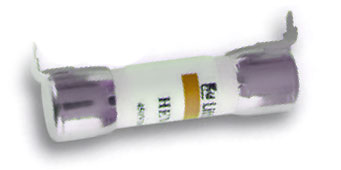
Pyro HV Fuse
Tesla uses a pyrotechnic fuse to disconnect the high-voltage pack in the event of a major overcurrent event. It provides the ability to allow high peak currents needed under maximum acceleration while still providing the required overload protection. The black pyro fuse is used in the Model 3 and Model Y.
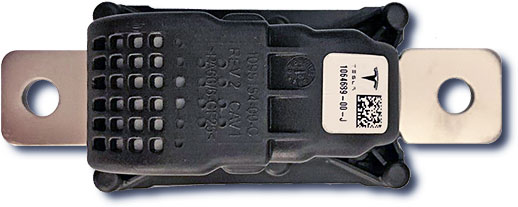
The Model S and Model X use an alternate design to handle larger peak currents. The Pyro fuse assembly includes a current shunt, current sensing electronics, two small non-rechargeable long-life lithium batteries, and two 100 amp fuses in parallel. If the electronics sense a major overcurrent event, such as a short in the motor inverter/motor assembly, it blows the pyro fuse. That causes all the current to pass through the two fuses which immediately blow. At this point, the HV is completely disconnected from the rest of the vehicle. There are no CAN bus or 12v power connections to this module, as it is completely self-contained.
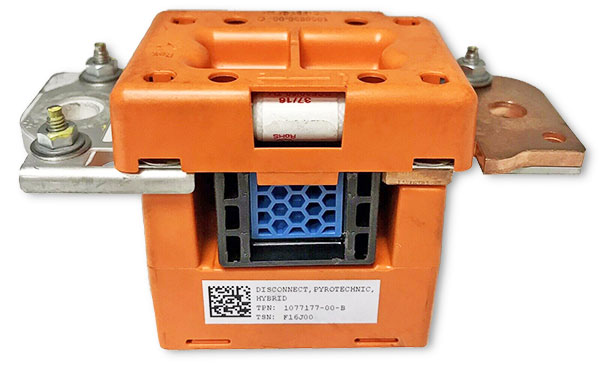
Inverter Fuses
The inverters on the Model S/X, and possibly the newest 3/Y, use a clever combination of two fuses and a pyrotechnic device to protect the inverter. Should a short occur inside the motor winding, or the HV wiring, the overcurrent is detected by electronics, and the pyrotechnic device is then activated. This sheers off part of the two power lugs that feed the motor. The high current also causes two connected fuses to blow. Munro associates has an excellent Motor teardown video showing the system in action. The inverter provides 3 phase power to the motor, so two of the three connections must be disconnected in the event of a short.
HV Battery Pack Fuses
Inside the battery pack, are three additional fuses for external, non-motor high voltage connections. These fuses are SIBA RS309-MF rated at 63 A at 700V.
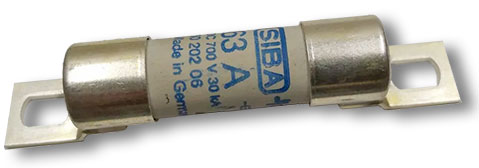
Model X (2015-2020)
This fuse information is for the Model X manufactured through 31-Dec-2020. Frunk fuses are located in the frunk area, behind the center black cover plastic panel. The left side of the center console is removed to access the Cabin fusebox and the right side is removed to access the Aux fusebox.
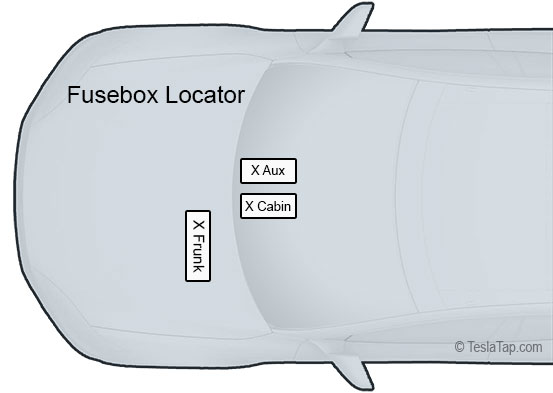
Cabin Fusebox - Fuse Locations
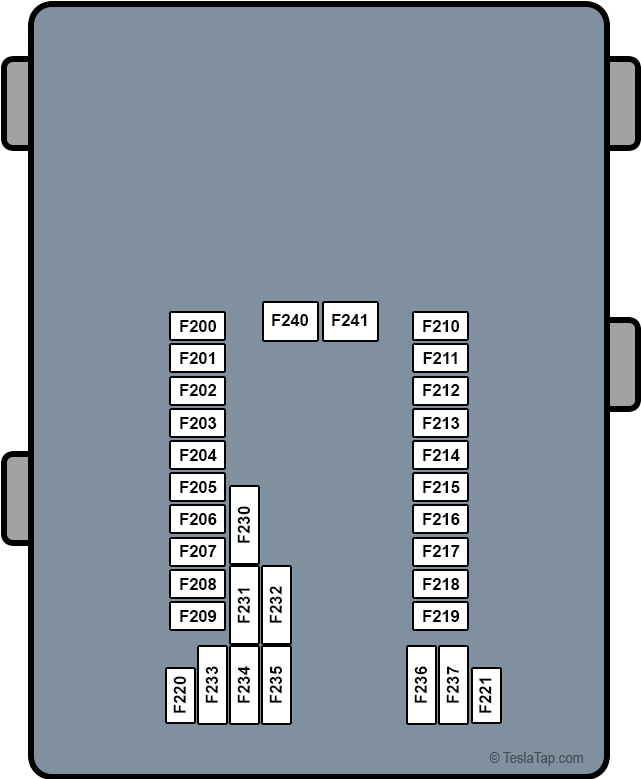
Cabin Fusebox for Model X (manufactured from 1-Sep-2015 to 31-Dec-2020)
| Id | Function | Type | Amps | Image |
|---|---|---|---|---|
| F200 | Seat Memory | Micro2 | 5 |  |
| F201 | Window Motor, Left Rear | Micro2 | 25 |  |
| F202 | 12V Accessory Power Socket, Trunk | Micro2 | 15 |  |
| F203 | unused | Micro2 | ||
| F204 | Window Motor, Right Front | Micro2 | 25 |  |
| F205 | Window Motor, Left Front | Micro2 | 25 |  |
| F206 | Central Body Controller, Steering Column Adjust | Micro2 | 25 |  |
| F207 | Center Console, USB Hub | Micro2 | 15 |  |
| F208 | 12V Accessory Power Socket, Front | Micro2 | 20 |  |
| F209 | Rear View Camera Electronic Control Unit | Micro2 | 15 |  |
| F210 | Power Liftgate | Micro2 | 30 |  |
| F211 | Window Motor, Right Rear | Micro2 | 25 |  |
| F212 | Electric Park Brake - Primary | Micro2 | 20 |  |
| F213 | Electric Park Brake - Secondary | Micro2 | 20 |  |
| F214 | unused | Micro2 | ||
| F215 | Steering Wheel Heater | Micro2 | 10 |  |
| F216 | Rear Body Controls | Micro2 | 25 |  |
| F217 | Premium Audio Amplifier | Micro2 | 20 |  |
| F218 | Base Audio Amplifier | Micro2 | 20 |  |
| F219 | Diagnostic Port, OBD-II, Glove Box Light | Micro2 | 5 |  |
| F220 | Brake Pedal Switch | Micro2 | 5 |  |
| F221 | Battery Management System | Micro2 | 5 |  |
| F230 | Third Row USB/unused | Micro3 | 15 |  |
| F231 | unused/unused | Micro3 | ||
| F232 | Seat Heaters Front: Left/Right | Micro3 | 15 |  |
| F233 | Door Latches Front: Left/Right | Micro3 | 15 |  |
| F234 | Door Controls Rear: Left/Right | Micro3 | 15 |  |
| F235 | Charging Systems/Center Display | Micro3 | 10 |  |
| F236 | SCCM & iBooster IGN/ACC Sense, Rearview Mirror, Radio, TPMS | Micro3 | 5 |  |
| F237 | iBooster/Instrument Cluster | Micro3 | 5 |  |
| F240 | Seat Motors, Front Right (30 A in older models) | Mcase | 25 |  |
| F241 | Seat Motors, Front Left (30 A in older models) | Mcase | 25 |  |
Frunk Top Fusebox - Fuse Locations

Frunk Side Fusebox - Fuse Locations
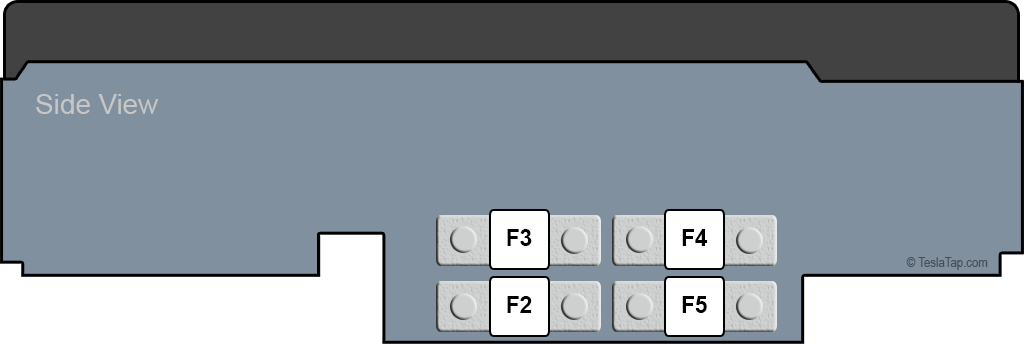
Frunk Fusebox for Model X (manufactured from 1-Sep-2015 to 31-Dec-2020)
| Id | Function | Type | Amps | Image |
|---|---|---|---|---|
| F1 | DC-DC Power Input | Mega | 250 |  |
| F2 | Power Steering | Midi | 80 |  |
| F3 | unused | Midi | ||
| F4 | Cabin Fuse Box | Midi | 125 |  |
| F5 | Aux Fuse Box | Midi | 200 |  |
| F100 | Siren and Intrusion Sensor | Micro2 | 5 |  |
| F101 | Forward Camera | Micro2 | 15 |  |
| F102 | unused | Micro2 | ||
| F103 | ABS - Valves | Micro2 | 25 |  |
| F104 | 12V Battery Monitor | Micro2 | 5 |  |
| F105 | Trailer Lights | Micro2 | 15 |  |
| F106 | unused | Micro2 | ||
| F107 | Drive Inverter, Rear | Micro2 | 5 |  |
| F108 | Drive Rail Sense | Micro2 | 5 |  |
| F109 | unused | Micro2 | ||
| F110 | Restraints Control Module | Micro2 | 5 |  |
| F111 | Trailer Brakes Controller, Customer supplied | Micro2 | 20 |  |
| F112 | Cabin Climate Controls, Front / Ionizer | Micro2 | 5 |  |
| F113 | Cabin Heater, Rear Climate Control, Air Quality Sensor | Micro2 | 10 |  |
| F114 | Thermal Controller, Battery Heater, Inlet, Chiller Valve | Micro2 | 10 |  |
| F115 | unused | Micro2 | ||
| F116 | unused | Micro2 | 10 |  |
| F117 | Air Suspension | Micro2 | 10 |  |
| F118 | Windshield Wiper | Micro2 | 25 |  |
| F120 | Second row Seats Secondary Power - tilt | Micro2 | 30 |  |
| F121 | unused | Micro2 | ||
| F122 | Coolant Pump 3 | Micro2 | 15 |  |
| F123 | Coolant Pump 2 | Micro2 | 15 |  |
| F124 | Windshield wiper De-ice | Micro2 | 10 |  |
| F125 | Contactor Power | Micro2 | 10 |  |
| F126 | unused | Micro2 | ||
| F127 | unused | Micro2 | ||
| F130 | Forward Radar | Micro2 | 15 |  |
| F131 | Trailer Connector | Micro2 | 15 |  |
| F132 | Drive Inverter, Front | Micro2 | 5 |  |
| F133 | unused | Micro2 | ||
| F134 | Headlamp, Right | Micro2 | 20 |  |
| F135 | unused | Micro2 | ||
| F136 | Coolant Pump 4 | Micro2 | 15 |  |
| F137 | Coolant Pump 1 | Micro2 | 15 |  |
| F138 | Rear Defrost Grid | Micro2 | 30 |  |
| F139 | Horns | Micro2 | 15 |  |
| F140 | unused | Micro2 | ||
| F141 | unused | Micro2 | ||
| F142 | unused | Micro2 | 15 |  |
| F143 | Central Body Controller | Micro2 | 20 |  |
| F144 | Headlamp, Left | Micro2 | 20 |  |
| F145 | Front Body Controller | Micro2 | 15 |  |
| F150 | Left Front Door Actuator | Jcase LP | 25 | 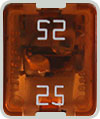 |
| F151 | ABS - Motor | Jcase LP | 50 | 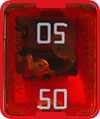 |
| F152 | Rear Cabin Blower | Jcase LP | 25 |  |
| F153 | unused | Jcase LP | ||
| F154 | Air Suspension Compressor | Jcase LP | 40 | 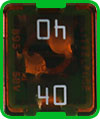 |
| F155 | Condenser Fan | Jcase LP | 60 | 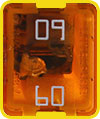 |
| F156 | iBooster / Brake Assist | Jcase LP | 40 |  |
| F160 | Cabin Blower, Front | Mcase | 30 |  |
| F161 | Right Front Door Actuator | Mcase | 25 |  |
| K100 | Cabin Blower, Rear | Relay | ||
| K101 | HVAC Group 1 | Relay | ||
| K102 | Rear Defrost Grid | Relay | ||
| K110 | Drive Rail Power | Relay | ||
| K111 | HVAC | Relay | ||
| K112 | Air Suspension Controller | Relay |
Aux Fusebox - Fuse Locations
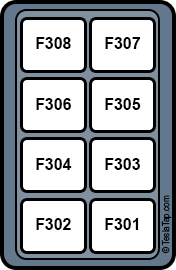
Aux Fusebox for Model X (manufactured from 1-Sep-2015 to 31-Dec-2020)
| Id | Function | Type | Amps | Image |
|---|---|---|---|---|
| F301 | Left Rear Door Actuators | Jcase LP | 60 |  |
| F302 | Right Rear Door Actuators | Jcase LP | 60 |  |
| F303 | Right Rear Door Actuators | Jcase LP | 60 |  |
| F304 | Left Rear Door Actuators | Jcase LP | 60 |  |
| F305 | Second Row Seat Power, Left | Jcase LP | 30 | 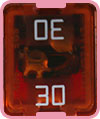 |
| F306 | Second Row Seat Power, Middle | Jcase LP | 30 |  |
| F307 | Second Row Seat Power, Right | Jcase LP | 30 |  |
| F308 | Trailer Brakes Power | Jcase LP | 30 |  |
Model S Refreshed (2016-2020)
This fuse information is for the refreshed Model S manufactured from 1-Jun-2016 through 31-Dec-2020. Frunk fuses are located in the frunk area, behind the center black cover plastic panel. The Cabin fuses are located behind the right side sill panel near the firewall.
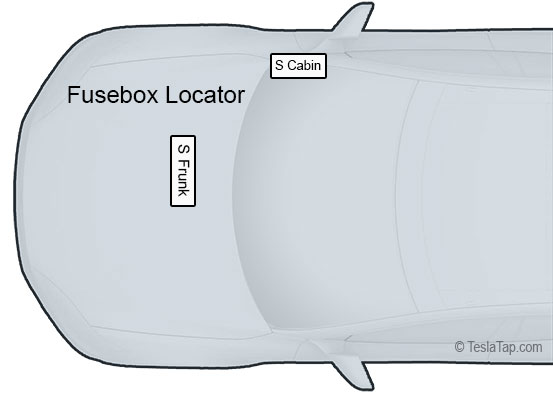
Cabin Fusebox - Fuse Locations

Cabin Fusebox for Model S (manufactured from 1-Jun-2016 to 31-Dec-2020)
| Id | Function | Type | Amps | Image |
|---|---|---|---|---|
| F200 | Seat Memory | Micro2 | 5 |  |
| F201 | Window Motor, Left Rear | Micro2 | 25 |  |
| F202 | 12V Accessory | Micro2 | 15 |  |
| F203 | unused | Micro2 | ||
| F204 | Window Motor, Right Front | Micro2 | 25 |  |
| F205 | Window Motor, Left Front | Micro2 | 25 |  |
| F206 | Panoramic Roof | Micro2 | 25 |  |
| F207 | 12V Accessory Power Socket, USB hub | Micro2 | 15 |  |
| F208 | unused | Micro2 | ||
| F209 | unused | Micro2 | ||
| F210 | Power Liftgate | Micro2 | 30 |  |
| F211 | Window Motor, Right Rear | Micro2 | 25 |  |
| F212 | Electric Park Brake - Primary | Micro2 | 20 |  |
| F213 | Electric Park Brake - Secondary | Micro2 | 20 |  |
| F214 | unused | Micro2 | ||
| F215 | Steering Wheel Heater | Micro2 | 10 |  |
| F216 | unused | Micro2 | ||
| F217 | Premium Audio Amplifier | Micro2 | 20 |  |
| F218 | Base Audio Amplifier | Micro2 | 20 |  |
| F219 | Diagnostic Port, OBD-II, Glove Box Light | Micro2 | 5 |  |
| F220 | Brake Pedal Switch | Micro2 | 5 |  |
| F221 | Battery Management System | Micro2 | 5 |  |
| F230 | Seat Heater, 2nd Row: Right/unused | Micro3 | 15 |  |
| F231 | Seat Heater, 2nd Row: Left/Middle | Micro3 | 15 |  |
| F232 | Seat Heaters, Front: Left/Right | Micro3 | 15 |  |
| F233 | Door Controls and Front Handles: Left/Right | Micro3 | 10 |  |
| F234 | Door Handles Rear: Left/Right | Micro3 | 5 |  |
| F235 | Gateway & Center Display/Charging Systems | Micro3 | 10 |  |
| F236 | Steering Angle & Column/Radio, Vanity Lights, Rearview Mirror | Micro3 | 5 |  |
| F237 | iBooster/Instrument Cluster | Micro3 | 5 |  |
| F240 | Seat Motors, Front Right | Mcase | 30 |  |
| F241 | Seat Motors, Front Left | Mcase | 30 |  |
Frunk Top Fusebox - Fuse Locations

Frunk Side Fusebox - Fuse Locations

Frunk Fusebox for Model S (manufactured from 1-Jun-2016 to 31-Dec-2020)
| Id | Function | Type | Amps | Image |
|---|---|---|---|---|
| F1 | DC-DC Power Input | Mega | 250 |  |
| F2 | Power Steering | Midi | 60 |  |
| F3 | unused | Midi | ||
| F4 | Cabin Fuse Box | Midi | 125 |  |
| F5 | unused | Midi | ||
| F100 | Siren and Intrusion Sensor | Micro2 | 5 |  |
| F101 | Forward Camera | Micro2 | 15 |  |
| F102 | unused | Micro2 | ||
| F103 | ABS - Valves | Micro2 | 25 |  |
| F104 | 12V Battery Monitor | Micro2 | 5 |  |
| F105 | unused | Micro2 | ||
| F106 | unused | Micro2 | ||
| F107 | Drive Inverter, Rear | Micro2 | 5 |  |
| F108 | Drive Rail Sense | Micro2 | 5 |  |
| F109 | Park Assist | Micro2 | 10 |  |
| F110 | Restraints Control Module | Micro2 | 5 |  |
| F111 | unused | Micro2 | ||
| F112 | Cabin Climate Controls, Front / Ionizer | Micro2 | 5 |  |
| F113 | Cabin Heater, Rear Climate Control, Air Quality Sensor | Micro2 | 10 |  |
| F114 | Thermal Controller, Battery Heater, Inlet, Chiller Valve | Micro2 | 10 |  |
| F115 | unused | Micro2 | ||
| F116 | Body Controls Group 1 | Micro2 | 10 |  |
| F117 | Air Suspension | Micro2 | 10 |  |
| F118 | unused | Micro2 | ||
| F120 | unused | Micro2 | ||
| F121 | unused | Micro2 | ||
| F122 | Coolant Pump 3 | Micro2 | 15 |  |
| F123 | Coolant Pump 2 | Micro2 | 15 |  |
| F124 | Windshield wiper De-ice | Micro2 | 10 |  |
| F125 | Contactor Power | Micro2 | 10 |  |
| F126 | unused | Micro2 | ||
| F127 | unused | Micro2 | ||
| F130 | Forward Radar | Micro2 | 15 |  |
| F131 | unused | Micro2 | ||
| F132 | Drive Inverter, Front | Micro2 | 5 |  |
| F133 | unused | Micro2 | ||
| F134 | unused | Micro2 | ||
| F135 | Forward Camera Defog | Micro2 | 10 |  |
| F136 | Coolant Pump 4 | Micro2 | 15 |  |
| F137 | Coolant Pump 1 | Micro2 | 15 |  |
| F138 | Rear Defrost Grid | Micro2 | 30 |  |
| F139 | unused | Micro2 | ||
| F140 | unused | Micro2 | ||
| F141 | unused | Micro2 | ||
| F142 | Security Controls, locking, horns, and steering heater | Micro2 | 15 |  |
| F143 | Body Controls 2 | Micro2 | 30 |  |
| F144 | Headlamps | Micro2 | 20 |  |
| F145 | Exterior Lighting | Micro2 | 25 |  |
| F150 | Condenser Fan, Left | Jcase LP | 40 |  |
| F151 | ABS - Motor | Jcase LP | 50 |  |
| F152 | unused | Jcase LP | ||
| F153 | unused | Jcase LP | ||
| F154 | Air Suspension Compressor | Jcase LP | 40 |  |
| F155 | Condenser Fan, Right | Jcase LP | 40 |  |
| F156 | iBooster / Brake Assist | Jcase LP | 40 |  |
| F160 | Cabin Blower | Mcase | 30 |  |
| F161 | unused | Mcase | ||
| K100 | unused | Relay | ||
| K101 | HVAC Group 1 | Relay | ||
| K102 | Rear Defrost Grid | Relay | ||
| K110 | Drive Rail Power | Relay | ||
| K111 | HVAC | Relay | ||
| K112 | Air Suspension Controller | Relay |
Original Model S (2012-2016)
This fuse information is for the original Model S manufactured from 22-June-2012 through 31-May-2016, prior to HW2 refresh. Most fuses are located in the frunk area, behind the center black cover plastic panels. The DC-DC Inverter and Front HV Junction box are located low on the firewall and are not easily accessible. Check the vehicle’s production date carefully, as we document the fuse functions when changes were made.

Cabin 1 Fusebox - Fuse Locations
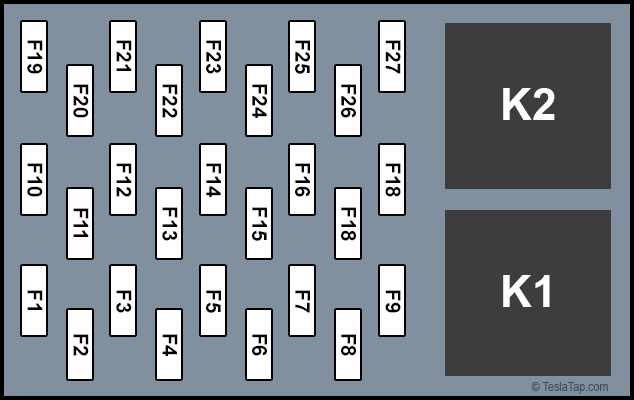
Cabin 1 Fusebox for Model S (manufactured from 22-Jun-2012 to 10-Jul-2014)
| Id | Function | Type | Amps | Image |
|---|---|---|---|---|
| F1 | ACC sense, Radio, USB hub | Mini | 5 |  |
| F2 | Headlamp Leveling (after 30-May-2013) | Mini | 5 |  |
| F3 | Rearview Mirror | Mini | 5 |  |
| F4 | Cold Weather Package, Group 1 (after 30-May-2013) | Mini | 30 |  |
| F5 | Seat Heater, Front Left | Mini | 15 |  |
| F6 | Base Audio Amplifier | Mini | 20 |  |
| F7 | Seat Heater, Front Right | Mini | 15 |  |
| F8 | Premium Amplifier | Mini | 20 |  |
| F9 | Panoramic Sunroof | Mini | 25 |  |
| F10 | Passive Safety Restraints | Mini | 5 |  |
| F11 | Steering Column Controls | Mini | 5 |  |
| F12 | Drive Sense, Yaw Sensor | Mini | 5 |  |
| F13 | Wiper | Mini | 15 |  |
| F14 | Drive Inverter | Mini | 5 |  |
| F15 | Parking Brake | Mini | 20 |  |
| F16 | Parking (after 30-May-2013) | Mini | 5 |  |
| F17 | Parking Brake | Mini | 20 |  |
| F18 | unused | Mini | ||
| F19 | HVAC In-car sensor | Mini | 5 |  |
| F20 | Cabin Heater Logic | Mini | 5 |  |
| F21 | Coolant Pump 2 | Mini | 15 |  |
| F22 | Inlet Actuators | Mini | 5 |  |
| F23 | Coolant Pump 3 | Mini | 15 |  |
| F24 | Cabin Climate Control | Mini | 5 |  |
| F25 | Coolant Pump 1 | Mini | 15 |  |
| F26 | Coolant Heater Logic (after 05-Jan-2014) | Mini | 15 |  |
| F27 | Thermal Controller | Mini | 10 |  |
| K1 | Accessory Power Relay | Relay | ||
| K2 | HVAC Power Relay | Relay |
Cabin 1 Fusebox for Model S (manufactured from 11-Jul-2014 to 31-May-2016)
| Id | Function | Type | Amps | Image |
|---|---|---|---|---|
| F1 | Wiper | Mini | 15 |  |
| F2 | Headlamp Leveling | Mini | 10 |  |
| F3 | Seat Heater, Second Row Right | Mini | 15 |  |
| F4 | Seat Heater, Second Row Middle | Mini | 15 |  |
| F5 | Seat Heater, Front Right | Mini | 15 |  |
| F6 | unused | Mini | ||
| F7 | Parking Brake, Secondary | Mini | 20 |  |
| F8 | Steering Column Module | Mini | 5 |  |
| F9 | Base Audio System | Mini | 20 |  |
| F10 | Panoramic Sunroof | Mini | 25 |  |
| F11 | unused | Mini | ||
| F12 | Seat Heater, Second Row Left | Mini | 15 |  |
| F13 | Cabin HVAC Functions | Mini | 5 |  |
| F14 | Seat Heater, Front Left | Mini | 15 |  |
| F15 | Coolant Pump 4 (after 28-Oct-2014, AWD Only) | Mini | 15 |  |
| F16 | Parking Brake, Primary | Mini | 20 |  |
| F17 | Coolant Pump 2 | Mini | 15 |  |
| F18 | Premium Audio Amplifier | Mini | 20 |  |
| F19 | unused | Mini | ||
| F20 | unused | Mini | ||
| F21 | Park Assist | Mini | 10 |  |
| F22 | Thermal Controller | Mini | 10 |  |
| F23 | unused | Mini | ||
| F24 | Coolant Pump 3 | Mini | 15 |  |
| F25 | Drive Inverter | Mini | 5 |  |
| F26 | Coolant Pump 1 | Mini | 15 |  |
| F27 | Restraints Control Module | Mini | 5 |  |
| K1 | Accessory Power Relay | Relay | ||
| K2 | HVAC Power Relay | Relay |
Cabin 2 Fusebox - Fuse Locations
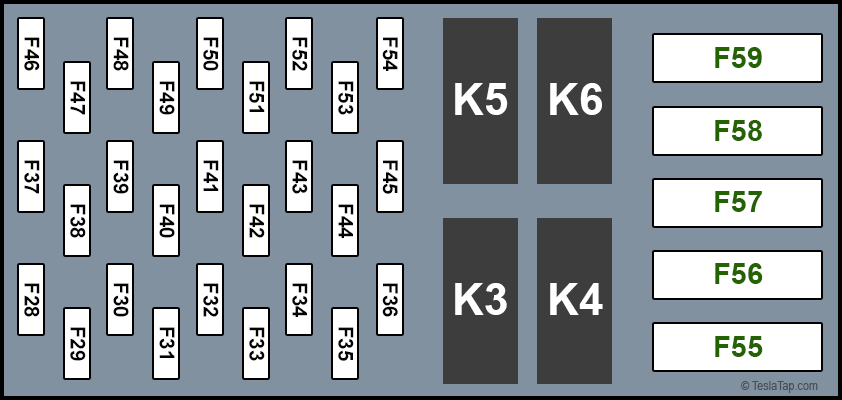
Cabin 2 Fusebox for Model S (manufactured from 22-Jun-2012 to 10-Jul-2014)
| Id | Function | Type | Amps | Image |
|---|---|---|---|---|
| F28 | Window Lift Motor, Right Rear | Mini | 25 |  |
| F29 | Contactor Power | Mini | 10 |  |
| F30 | Window Lift Motor, Right Front | Mini | 25 |  |
| F31 | unused | Mini | ||
| F32 | Door Controls, Right Side | Mini | 10 |  |
| F33 | unused | Mini | ||
| F34 | Cold Weather Package Group 2 (after 30-May-2013) | Mini | 30 |  |
| F35 | 12V Accessory Power Socket | Mini | 15 |  |
| F36 | Air Suspension Control, Valves | Mini | 25 |  |
| F37 | Window Lift Motor, Left Rear | Mini | 25 |  |
| F38 | Driver's Seat Memory | Mini | 5 |  |
| F39 | Window Lift Motor, Left Front | Mini | 25 |  |
| F40 | Rear Door Handles | Mini | 5 |  |
| F41 | Door Controls, Left Side | Mini | 10 |  |
| F42 | Power Liftgate | Mini | 30 |  |
| F43 | Perm. Power Sense, Brake Switch | Mini | 5 |  |
| F44 | Chargers, Charge Port | Mini | 5 |  |
| F45 | Passive Entry, Horns | Mini | 20 |  |
| F46 | Body Controls, Group 2 | Mini | 30 |  |
| F47 | Glove Box Light | Mini | 5 |  |
| F48 | Body Controls, Group 1 | Mini | 10 |  |
| F49 | Instrument Cluster, OBD-II | Mini | 5 |  |
| F50 | Siren, Intrusion/Tilt Sensor (after 30-May-2013) | Mini | 5 |  |
| F51 | Center Display and Main Computer | Mini | 20 |  |
| F52 | Rear Window Defrost Grid | Mini | 30 |  |
| F53 | Battery Management System | Mini | 5 |  |
| F54 | unused | Mini | ||
| F55 | Left Front Seat Adjust Motor | Maxi | 30 |  |
| F56 | Right Front Seat Adjust Motor | Maxi | 30 |  |
| F57 | Cabin Fan | Maxi | 25 |  |
| F58 | unused | Maxi | ||
| F59 | unused | Maxi | ||
| K3 | 12V Outlet Switch | Relay | ||
| K4 | unused | Relay | ||
| K5 | Rear Defrost Grid | Relay | ||
| K6 | Front Defrost Grid (before 31-May-2013) | Relay |
Cabin 2 Fusebox for Model S (manufactured from 11-Jul-2014 to 31-May-2016)
| Id | Function | Type | Amps | Image |
|---|---|---|---|---|
| F28 | Window Lift Motor, Right Rear | Mini | 25 |  |
| F29 | Contactor Power | Mini | 10 |  |
| F30 | Window Lift Motor, Right Front | Mini | 25 |  |
| F31 | Forward Camera / Active Safety | Mini | 15 |  |
| F32 | Door Controls, Right Side | Mini | 10 |  |
| F33 | 12V Accessory Spare | Mini | 15 |  |
| F34 | Forward Camera Defog | Mini | 10 |  |
| F35 | 12V Accessory Power Socket | Mini | 15 |  |
| F36 | Air Suspension Control, Valves | Mini | 10 |  |
| F37 | Window Lift Motor, Left Rear | Mini | 25 |  |
| F38 | Driver's Seat Memory | Mini | 5 |  |
| F39 | Window Lift Motor, Left Front | Mini | 25 |  |
| F40 | Rear Door Handles | Mini | 5 |  |
| F41 | Door Controls, Left Side | Mini | 10 |  |
| F42 | Power Liftgate | Mini | 30 |  |
| F43 | Perm. Power Sense, Brake Switch | Mini | 5 |  |
| F44 | Chargers, Charge Port | Mini | 10 |  |
| F45 | Passive Entry, Horns, Security | Mini | 20 |  |
| F46 | Body Controls, Group 2 | Mini | 30 |  |
| F47 | Glove Box Light, OBD-II | Mini | 5 |  |
| F48 | Body Controls, Group 1 | Mini | 10 |  |
| F49 | Instrument Cluster | Mini | 5 |  |
| F50 | Siren, Intrusion/Tilt Sensor | Mini | 5 |  |
| F51 | Center Display and Main Computer | Mini | 20 |  |
| F52 | Rear Window Defrost Grid | Mini | 30 |  |
| F53 | Battery Management System | Mini | 5 |  |
| F54 | Wiper De-Icer | Mini | 15 |  |
| F55 | Left Front Seat Adjust Motor | Mini | 30 |  |
| F56 | Right Front Seat Adjust Motor | Mini | 30 |  |
| F57 | Cabin Fan | Mini | 30 |  |
| F58 | 12V Outlet/Forward Camera | Mini | 30 |  |
| F59 | HVAC 2 Power (Not on AWD) | Mini | 30 |  |
| K3 | 12V Outlet Switch | Relay | ||
| K4 | Wiper De-Ice | Relay | ||
| K5 | Rear Defrost Grid | Relay | ||
| K6 | HVAC 2 Power switch (Not on AWD) | Relay |
Front Fusebox - Fuse Locations
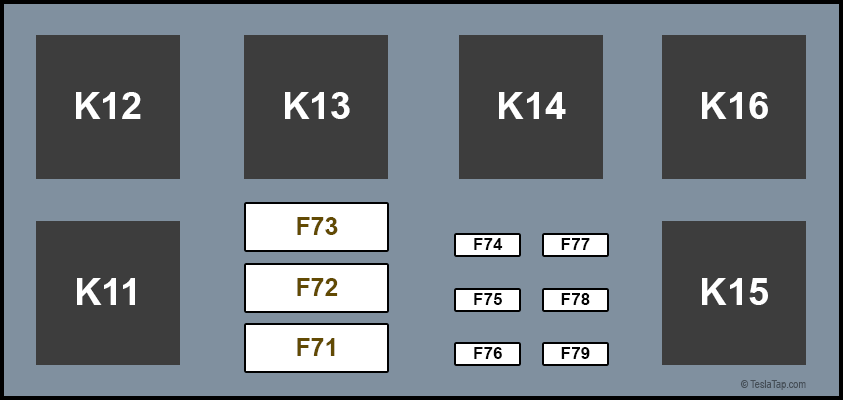
Front Fusebox for Model S (manufactured from 22-Jun-2012 to 10-Jul-2014)
| Id | Function | Type | Amps | Image |
|---|---|---|---|---|
| F71 | Condenser Fan, Left | Maxi | 40 |  |
| F72 | Condenser Fan, Right | Maxi | 40 |  |
| F73 | Vacuum Pump | Maxi | 40 |  |
| F74 | 12V Drive Rail, Cabin | Mini | 20 |  |
| F75 | Power Steering Logic - IGN | Mini | 5 |  |
| F76 | Power Steering Logic - IGN | Mini | 5 |  |
| F77 | Stability Control Valves | Mini | 25 |  |
| F78 | Headlight Dip, Main Beam | Mini | 20 |  |
| F79 | Lighting (Exterior/Interior) | Mini | 30 |  |
| K11 | Air Suspension Compressor | Relay | ||
| K12 | Vacuum Pump | Relay | ||
| K13 | Wiper Fast Function | Relay | ||
| K14 | Wiper Park Function | Relay | ||
| K15 | Condenser Fan Power | Relay | ||
| K16 | Drive Switched Power | Relay |
Front Fusebox for Model S (manufactured from 11-Jul-2014 to 31-May-2016)
| Id | Function | Type | Amps | Image |
|---|---|---|---|---|
| F71 | Condenser Fan, Left | Maxi | 40 |  |
| F72 | Condenser Fan, Right | Maxi | 40 |  |
| F73 | Vacuum Pump | Maxi | 40 |  |
| F74 | 12V Drive Rail, Cabin | Mini | 20 |  |
| F75 | unused | Mini | ||
| F76 | Drive Rail Sense | Mini | 5 |  |
| F77 | Stability Control Valves | Mini | 25 |  |
| F78 | Headlight Dip, Main Beam | Mini | 20 |  |
| F79 | Lighting (Exterior/Interior) | Mini | 30 |  |
| K11 | Air Suspension Compressor | Relay | ||
| K12 | Vacuum Pump | Relay | ||
| K13 | Wiper Fast Function | Relay | ||
| K14 | Wiper Park Function | Relay | ||
| K15 | Condenser Fan Power | Relay | ||
| K16 | Drive Switched Power | Relay |
Battery Fusebox - Fuse Locations
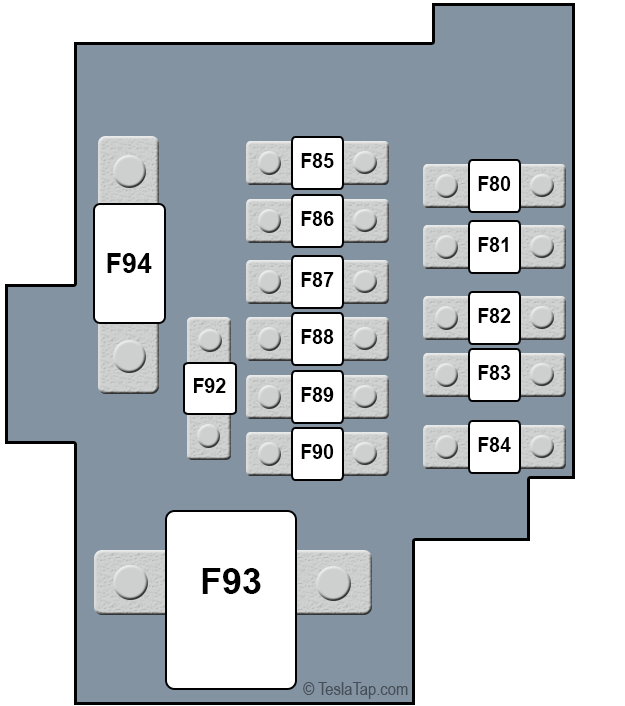
Battery Fusebox for Model S (manufactured from 22-Jun-2012 to 31-May-2016)
| Id | Function | Type | Amps | Image |
|---|---|---|---|---|
| F80 | Power Steering | Midi | 60 |  |
| F81 | Condenser Fans Master | Midi | 60 |  |
| F82 | Air Suspension Compressor | Midi | 40 |  |
| F83 | Jump Post | Midi | 50 |  |
| F84 | ABS Motor | Midi | 40 |  |
| F85 | Drive 12V Power Master | Midi | 50 |  |
| F86 | ACC 12V Bus Master | Midi | 50 |  |
| F87 | Permanent Power Group 1 | Midi | 50 |  |
| F88 | Permanent Power Group 2 | Midi | 50 |  |
| F89 | Permanent Power Group 3 | Midi | 50 |  |
| F90 | HVAC 12V Bus Master | Midi | 50 |  |
| F92 | Contactor Power | Midi | 30 |  |
| F93 | Contactor Power Cutoff (Pyrotechnic) | PyroFuse |  | |
| F94 | Battery-DC to DC Master | Mega | 225 |  |
DC-DC Gen 1 Fusebox - Fuse Locations
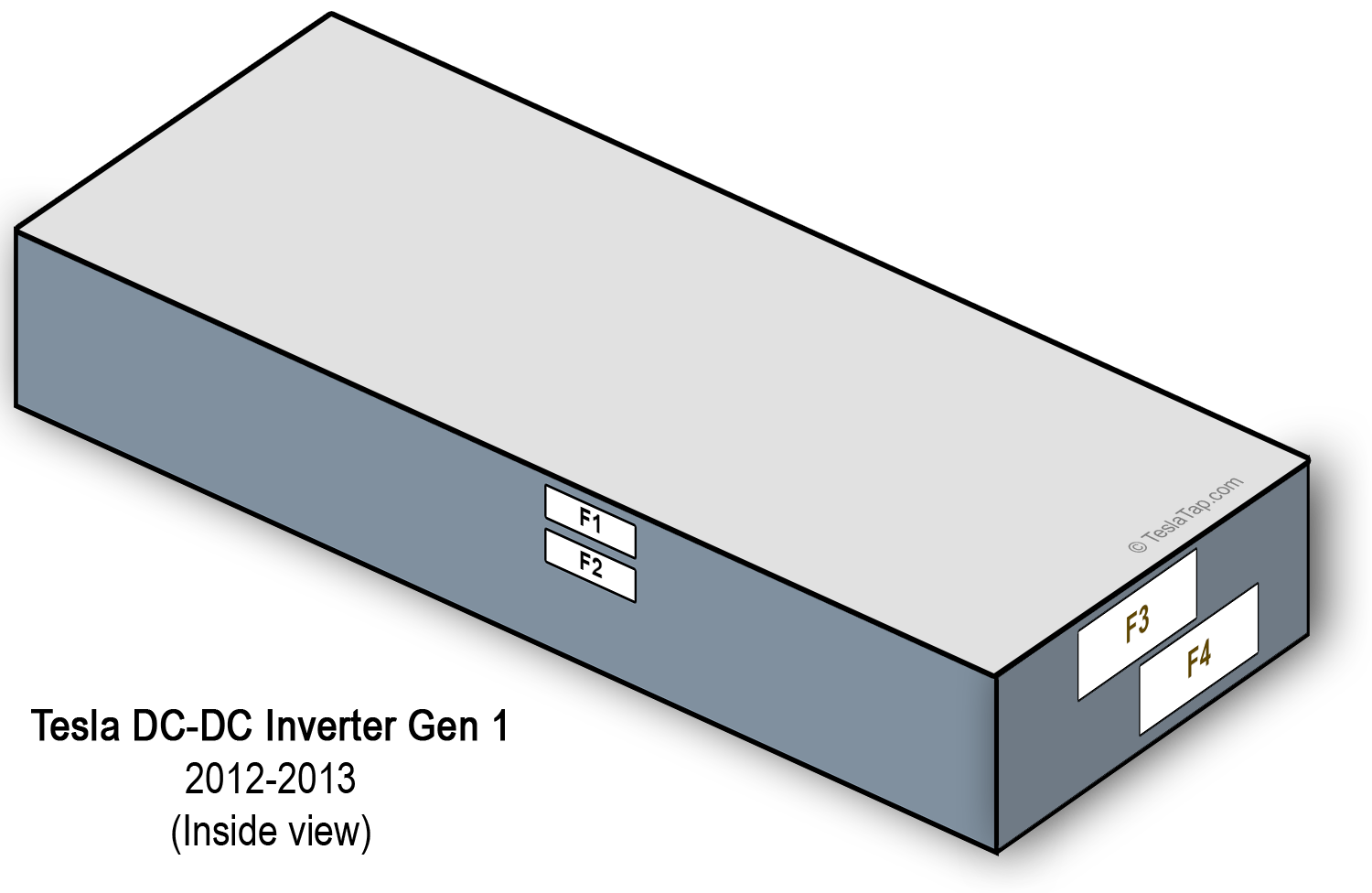
DC-DC Gen 1 Fusebox for Model S (manufactured from 22-Jun-2012 to 5-Jan-2014)
| Id | Function | Type | Amps | Image |
|---|---|---|---|---|
| F1 | PTC Coolant Heater* (Bussman FWH-20A14Fa; Tesla 1031238-00-A) | Ceramic | 20 |  |
| F2 | DC-DC Inverter* (Bussman FWH-20A14Fa; Tesla 1031238-00-A) | Ceramic | 20 |  |
| F3 | PTC Cabin Air Heater (Bussman FWP-40A14Fa; Tesla 1019010-00-A) | Ceramic | 40 |  |
| F4 | A/C Compressor (Bussman FWP-40A14Fa; Tesla 1019010-00-A) | Ceramic | 40 |  |
* Functions Unconfirmed
The DC-DC Converter is located on the lower part of the passenger-side firewall. The sealed module must be pulled apart to access the fuses.
Front HV Junction Fusebox - Fuse Locations

Front HV Junction Fusebox for Model S (manufactured from 6-Jan-2014 to 31-May-2016)
| Id | Function | Type | Amps | Image |
|---|---|---|---|---|
| F1 | PTC Coolant Heater (Bussman FWH-20A14Fa; Tesla 1031238-00-A) | Ceramic | 20 |  |
| F2 | A/C Compressor (Bussman FWP-40A14Fa; Tesla 1019010-00-A) | Ceramic | 40 |  |
| F3 | PTC Cabin Air Heater (Bussman FWP-40A14Fa; Tesla 1019010-00-A) | Ceramic | 40 |  |
| F4 | DC-DC Inverter Gen 2 (Bussman FWH-20A14Fa; Tesla 1031238-00-A) | Ceramic | 20 |  |
The fuses used may be different than the image shown.
The front HV junction box is located low near the center firewall. It is very difficult to access. On dual motor vehicles, either the HV battery or the Drive unit must be removed to access it. Once removed, the fuses are inside the sealed box.
Notes
- Dates of various changes are our best estimate of the vehicle’s manufacturing date and may be off slightly. Tesla shows the vehicle’s production month on the label near the B-pillar when the driver door is opened, but not the day of the month.
- Fuses locations, functions, and amperages are for the North-American Left-Hand-Drive vehicles but should be very close to other variants.
- Micro3 fuses are two fuses in one casing. We show the two functions separated by a slash.
- Some fuses are for optional features. A fuse may or may not be populated when the option is not equipped on a vehicle.